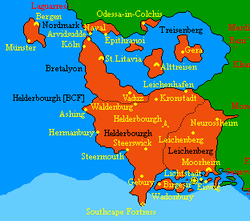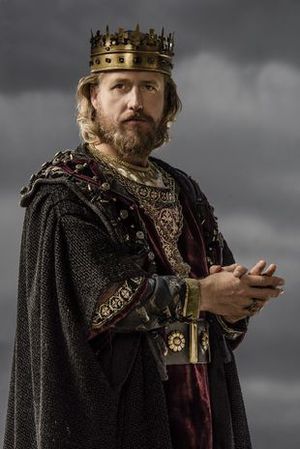Helderbourgh: Difference between revisions
No edit summary |
No edit summary |
||
| Line 12: | Line 12: | ||
|largecity = [[Helderbourgh Stadt]] | |largecity = [[Helderbourgh Stadt]] | ||
|lang = [[wikipedia:English language|English]], [[wikipedia:Dutch language|Dutch]]<br><small>The latter is primarily ceremonial</small> | |lang = [[wikipedia:English language|English]], [[wikipedia:Dutch language|Dutch]]<br><small>The latter is primarily ceremonial</small> | ||
|religion= [[Holy Catologian Church]] | |||
|demnoun = Helderbourgers | |demnoun = Helderbourgers | ||
|demadj = Helderbourgish | |demadj = Helderbourgish | ||
Revision as of 13:35, 3 July 2019
| Grand Duchy of Helderbourgh | |||
| |||
| Motto: Prospice Hellebergh | |||
| Anthem: Mountain Men (Unofficial) | |||

| |||
| Map versions | 6.8.3 - 6.8.5; 7.0.0 - 7.0.1; 14.9.4 - present | ||
| Capital | Helderbourgh Stadt | ||
| Largest city | Helderbourgh Stadt | ||
| Official language(s) | English, Dutch The latter is primarily ceremonial | ||
| Official religion(s) | Holy Catologian Church | ||
| Demonym | Helderbourgers | ||
| - Adjective | Helderbourgish | ||
| Government | Monarchy | ||
| - Grand Duke | Arkadius Frederik Gustavus des Vinandy | ||
| - None | None | ||
| - Legislature | 'Assembly of Estatesl | ||
| Establishment | 12 Winter month 1667 AN (12 December 2018) | ||
| Area | 9,728,732 km² | ||
| Population | 15,271,844 | ||
| Active population | 1 | ||
| Currency | Heldermark | ||
| Calendar | |||
| Time zone(s) | CMT-11 | ||
| Mains electricity | |||
| Driving side | |||
| Track gauge | |||
| National website | None | ||
| National forum | forum | ||
| National animal | None | ||
| National food | None | ||
| National drink | Birch Beer | ||
| National tree | Pitch Pine | ||
| Abbreviation | HLB | ||
Helderbourgh, officially Grand Duchy of Helderbourgh (Dutch: Groothertogdom Helderburg), is a wikibased country in the southwest of Cibola. With an area of 9,728,732 km² and with more than fifteen million inhabitants, the grand duchy is the largest country on the Cibola continent. The capital and largest city of the country is the eponymous Helderbourgh Stadt.
Helderbourgh is a parliamentary democracy with a grand duke as a constitutional monarch. Since 1672 AN Arkadius Frederik Gustavus des Vinandy has been the grand duke, creating a de facto personal union with Amokolia and Batavia. In the same year, Helderbourgh became a member of the Batavian Confederation.
Etymology
Helderbourgh was founded by Treiso-Batavians and means 'Bright City' in the local dialect. The name for the city comes, in turn, from the name of the mountain which it is situated upon, the Helderberg, or Bright Mountain.
Geography
The Grand Duchy encompasses roughly the southwestern quarter of Cibola, including the central and southern islands, except for Birgeshir and Caputia Monovia. The region is typified by several tall mountains that punctuate the central regions of Cibola, with a steeply declining elevation in terrain down to the surrounding ocean. Because of this drastic change in elevation the climate between different areas can vary significantly. Mountainous regions favor a mostly alpine climate, with the upper peaks often capped with permanent snow. On the other hand, Cibola's central sea, the Meergarten, has a more Mediterranean to temperate climate.
Helderbourgh Stadt is located atop a plateau sitting at the edge of an escarpment running along the western flank of Helderberg Mountain.
History
Prior to becoming a major city, Helderbourgh was a small village consisting of a few families of Treiso-Batavian descent. These original settlers hailed from Batavian Cibola, some two to three thousand years ago, when Batavia held colonies in what is presently Bretalyon. Over time these families intermarried with the Germanian population, and these families settled and named the Helderbergs.
Helderbourgh arose as a result of a protracted civil war within the United Principalities of Treisenberg. During the events of the White Plague, Treisenberg's principalities began to war with one another. In particular they came into conflict with the fanatical crusaders of Bretalyon. Helderberg Mountain became a refuge for those escaping the pillage wrought by the Knights. Soon the number of refugees became so great that the village and then city of Helderbourgh arose on the mountaintop. After the Grand Commander of the Knights was assassinated, the Bretalois sued for peace and the country was reorganized. With many cities utterly destroyed and others still in flames, Helderbourgh became the new center of the country.
In 1672 AN Arkadius Frederik Gustavus des Vinandy was named Grand Duke and the country joined the Batavian Confederation. Then in 1673 AN, Helderbourgh became an autonomous area of the Kingdom of Batavia.
Government
Helderbourgh is a parliamentary democracy headed by a constitutional monarch. Executive power is exercised by the Grand Duke and his Cabinet. A Constitution allows for basic rights and provides stipulations for governance. The Grand Duke has the power to dissolve the legislature, in which case parliamentary elections must be held within three months.
Legislative power is vested in the Assembly of Estates which is composed of sixteen representatives, four from each of the four cantons (Helderbourgh, Treisenberg, Bretalyon and Leichenberg).
The Grand Duchy has several lower Tribunals, one for the Supreme Court, one for State, one for Defense, and one for Internal Affairs.
Cantons
| Flag | Canton | Capital |
|---|---|---|
| Bretalyon | St. Litavia | |
| Canton Helderbourgh | Helderbourgh Stadt | |
| Leichenberg | Moorheim | |
| Treisenberg | Alttreisen |
Demographics
The country has a total population of 15,271,844 citizens.
The following was the ethnic breakdown of the country, according to the 2018 census:
- Helderbourghers: 5,271,844
- Treisenbergers: 3,500,000
- Bretalois: 3,000,000
- Leichenbergers: 2,500,000
Culture
Helderbourgh is a land dominated by the mountains of Cibola. As such the region has developed a distinct Alpine culture with influences from preceding nations such as Germania, Batavia and others.
Economy
Helderbourgh has a stable economy and has rebounded well since the end of the civil war. Industrial manufacturing is the largest sector of the economy, thanks in part to ample access to various metal ores in the mountains. The country is also a major producer of gold exports, having one of the largest gold mines on Micras. The majority of mining and industrial factories are located in the eastern region of the country, primarily in Leichenberg. A strong rail network links the hill town industrial centers to the main port, Leichenhafen, and transport to the world markets is through Treisenberg's sizable shipping network.
The region of Helderbourgh is known for tourism and its extensive fruit growing. This includes apple orchards and vineyards, which are suitable for the hilly terrain. The flatlands of Bretalyon are mostly agricultural, and serve as the main supplier of foodstuffs for the country. The southern polar reaches are sparsely populated and more of a subsistence economy.
Gold
Many gold concentrations can be found in the mountains of Helderbourgh. This makes Helderbourgh a global player in the gold trade. The Batavian Trading Company has the concession for the export of gold.
Military
The army is considered a civilian operation, with the Grand Duke serving as Commander-in-Chief. The Minister of Defense oversees military operations, while individual chiefs for the army, navy and air force each report to the minister.
Southcape (Sudkap) Fortress serves as the largest military installation and headquarters for the Helderbourger military. Several other smaller bases provide regional defense. The navy is headquartered at Alttreisen.



